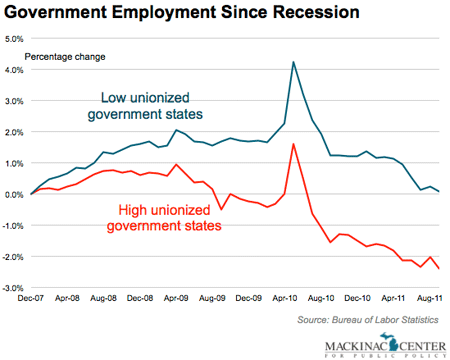Commentary
Government Unions: Bad for Government Services
Students in the Royal Oak school district will be reminded of the cost of unionized government every morning this year as school buses no longer pick them up. Regular bus service has been dropped in the district as the cost of employment protected by union contracts has increased. The number of employees in the district is down, as is student enrollment, but compensation for unionized employees continues its upward pace. This is not an isolated incident, but it is a small example of how unionized government is bad for both taxpayers and government services around the country.
Royal Oak's average teacher pay increased from $59,000 in 2004 to $73,000 in 2010. This is in addition to retirement benefits that increased from 12.99 percent of salary to 24.46 percent of salary, and health insurance benefits that currently cost the district nearly $20,000 per employee annually. Due to these cost increases, the number of teachers in the district dropped 27 percent, even though the number of students dropped only 14 percent.
Overall, government jobs were largely protected during the 2007-2009 recession, but have fallen since. Some states took a larger knock on their government jobs than others, which may have something to do with their unionization rules. Indeed, strong government union states — those mandating collective bargaining and without right-to-work laws — shed government jobs while the less unionized states increased government employment.
States get to pick their own rules for government employee unionism. Some states, like Michigan, are modeled after federally established private-sector union rules, while others give local government managers more discretion over the terms of government employment.
Since the beginning of the recession, the level of government employment in union-heavy states fell by 1.7 percent. It increased by 1.8 percent in union-light states. Both sets had a temporary spike during the 2010 Census.

While it may seem that unions protect government jobs, mandatory union rules actually lower government employment. This is because it locks in compensation rates but does not increase the government’s ability to pay for it. So when a government faces tough times, it can only adjust the level of employment instead of the cost drivers of that employment. The most frequently used options are offering early retirement incentives and laying off employees.
This can have consequences for service since these employment reductions may occur regardless of the need for work hours. A city’s public works project list doesn’t get smaller, nor will fewer students show up at school, nor will fewer fires need to be put out. But the layoffs will influence services.
A better approach would be to reform government unionism laws to ensure that elected officials and government managers have it in their power to put their services ahead of their union contracts. While the state has made some improvements already this year, there is more to do.
|

Government Unions: Bad for Government Services
Students in the Royal Oak school district will be reminded of the cost of unionized government every morning this year as school buses no longer pick them up. Regular bus service has been dropped in the district as the cost of employment protected by union contracts has increased. The number of employees in the district is down, as is student enrollment, but compensation for unionized employees continues its upward pace. This is not an isolated incident, but it is a small example of how unionized government is bad for both taxpayers and government services around the country.
Royal Oak's average teacher pay increased from $59,000 in 2004 to $73,000 in 2010. This is in addition to retirement benefits that increased from 12.99 percent of salary to 24.46 percent of salary, and health insurance benefits that currently cost the district nearly $20,000 per employee annually. Due to these cost increases, the number of teachers in the district dropped 27 percent, even though the number of students dropped only 14 percent.
Overall, government jobs were largely protected during the 2007-2009 recession, but have fallen since. Some states took a larger knock on their government jobs than others, which may have something to do with their unionization rules. Indeed, strong government union states — those mandating collective bargaining and without right-to-work laws — shed government jobs while the less unionized states increased government employment.
States get to pick their own rules for government employee unionism. Some states, like Michigan, are modeled after federally established private-sector union rules, while others give local government managers more discretion over the terms of government employment.
Since the beginning of the recession, the level of government employment in union-heavy states fell by 1.7 percent. It increased by 1.8 percent in union-light states. Both sets had a temporary spike during the 2010 Census.
While it may seem that unions protect government jobs, mandatory union rules actually lower government employment. This is because it locks in compensation rates but does not increase the government’s ability to pay for it. So when a government faces tough times, it can only adjust the level of employment instead of the cost drivers of that employment. The most frequently used options are offering early retirement incentives and laying off employees.
This can have consequences for service since these employment reductions may occur regardless of the need for work hours. A city’s public works project list doesn’t get smaller, nor will fewer students show up at school, nor will fewer fires need to be put out. But the layoffs will influence services.
A better approach would be to reform government unionism laws to ensure that elected officials and government managers have it in their power to put their services ahead of their union contracts. While the state has made some improvements already this year, there is more to do.
Michigan Capitol Confidential is the news source produced by the Mackinac Center for Public Policy. Michigan Capitol Confidential reports with a free-market news perspective.